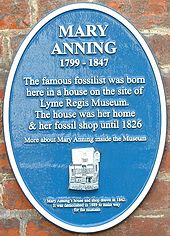
Dorset is a ceremonial county in South West England. It is bordered by Somerset to the north-west, Wiltshire to the north and the north-east, Hampshire to the east, the Isle of Wight across the Solent to the south-east, the English Channel to the south, and Devon to the west. The largest settlement is Bournemouth, and the county town is Dorchester.

Mary Anning was an English fossil collector, dealer, and palaeontologist. She became known internationally for her discoveries in Jurassic marine fossil beds in the cliffs along the English Channel at Lyme Regis in the county of Dorset, Southwest England. Anning's findings contributed to changes in scientific thinking about prehistoric life and the history of the Earth.

Lyme Regis is a town in west Dorset, England, 25 miles (40 km) west of Dorchester and east of Exeter. Sometimes dubbed the "Pearl of Dorset", it lies by the English Channel at the Dorset–Devon border. It has noted fossils in cliffs and beaches on the Jurassic Coast, a World Heritage Site and heritage coast. The harbour wall, known as The Cobb, appears in Jane Austen's novel Persuasion, the John Fowles novel The French Lieutenant's Woman and the 1981 film of that name, partly shot in the town.
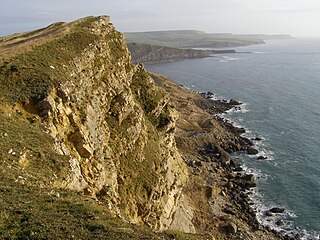
The Jurassic Coast is a World Heritage Site on the English Channel coast of southern England. It stretches from Exmouth in East Devon to Studland Bay in Dorset, a distance of about 96 miles (154 km), and was inscribed on the World Heritage List in mid-December 2001.

West Dorset was a local government district in Dorset, England. The district was formed on 1 April 1974 under the Local Government Act 1972, and was a merger of the boroughs of Bridport, Dorchester and Lyme Regis, along with Sherborne urban district and the rural districts of Beaminster, Bridport, Dorchester and Sherborne. Its council was based in Dorchester.

Charmouth is a village and civil parish in west Dorset, England. The village is situated on the mouth of the River Char, around 1+1⁄2 miles (2 km) north-east of Lyme Regis. Dorset County Council estimated that in 2013 the population of the civil parish was 1,310. In the 2011 Census the population of the parish, combined with the small parish of Catherston Leweston to the north, was 1,352.

Eleanor Coade was a British businesswoman known for manufacturing Neoclassical statues, architectural decorations and garden ornaments made of Lithodipyra for over 50 years from 1769 until her death. She should not be confused or conflated with her mother, also named Eleanor.

The Blue Lias is a geological formation in southern, eastern and western England and parts of South Wales, part of the Lias Group. The Blue Lias consists of a sequence of limestone and shale layers, laid down in latest Triassic and early Jurassic times, between 195 and 200 million years ago. The Blue Lias is famous for its fossils, especially ammonites.
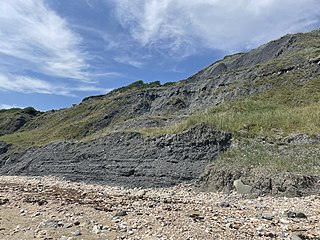
Black Ven is a cliff in Dorset, England between the towns of Charmouth and Lyme Regis. The cliffs reach a height of 130 metres (430 ft). It is part of the Jurassic Coast World Heritage Site. Nearby is an undercliff with an ammonite pavement. The area is popular with tourists due to a number of fossils being found in the area.

The Spittles is an area of coastal cliff in the county of Dorset on the south coast of England. It is situated between the settlements of Lyme Regis to the west and Charmouth to the east. It forms part of the Jurassic Coast, a World Heritage Site designated in 2001. The cliff contains layers of Blue Lias and clay; in wet seasons the clay causes the layers above to become saturated and hence landslips occur, exposing many fossils. Mary Anning famously found an Ichthyosaurus in the Spittles.

Duria Antiquior, a more ancient Dorset, was the first pictorial representation of a scene of prehistoric life based on evidence from fossil reconstructions, a genre now known as paleoart.

Elizabeth Philpot (1779–1857) was an early 19th-century British fossil collector, amateur palaeontologist and artist who collected fossils from the cliffs around Lyme Regis in Dorset on the southern coast of England. She is best known today for her collaboration and friendship with the well known fossil hunter Mary Anning. She was well known in geological circles for her knowledge of fossil fish as well as her extensive collection of specimens and was consulted by leading geologists and palaeontologists of the time including William Buckland, and Louis Agassiz. When Mary Anning discovered that belemnite fossils contained ink sacs, it was Philpot who discovered that the fossilised ink could be revivified with water and used for illustrations, which became a common practice for local artists.
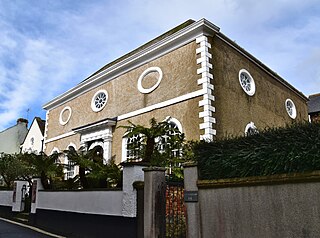
Dinosaurland Fossil Museum is a privately owned fossil museum in Lyme Regis, on the Jurassic Coast in Dorset, England. The museum is located in a historic Grade I listed former congregational church building.
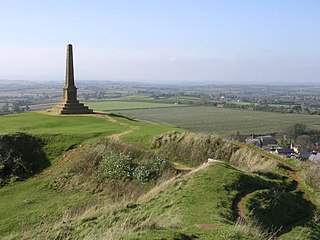
The Liberty Trail is a 28-mile (45.1 km) trail between Ham Hill in Somerset and Lyme Regis in Dorset, England.

Dorset is a county located in the middle of the south coast of England. It lies between the latitudes 50.512°N and 51.081°N and the longitudes 1.682°W and 2.958°W, and occupies an area of 2,653 km2. It spans 90 kilometres (56 mi) from east to west and 63 kilometres (39 mi) from north to south.

Anningasaura is an extinct genus of basal plesiosaur. It is known from a single type species, A. lymense, discovered in Early Jurassic rocks of Lyme Regis in the United Kingdom.

The Charmouth Mudstone Formation is a geological formation in England, dating to the Early Jurassic (Sinemurian–Pliensbachian). It forms part of the lower Lias Group. It is most prominently exposed at its type locality in cliff section between Lyme Regis and Charmouth but onshore it extends northwards to Market Weighton, Yorkshire, and in the subsurface of the East Midlands Shelf and Wessex Basin. The formation is notable for its fossils, including those of ammonites and marine reptiles and rare dinosaur remains. The formation played a prominent role in the history of early paleontology, with its Lyme Regis-Charmouth exposure being frequented by fossil collectors including Mary Anning.
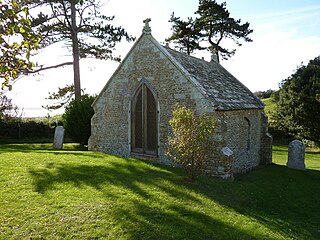
The Great Storm of 1824 was a hurricane force wind and storm surge that affected the south coast of England from 22 November 1824. The storm raged for two days.

Lyme Regis Cemetery is the principal cemetery in the English town of Lyme Regis, Dorset. Estimates for the number of burials in the cemetery range from 3,570 to over 5,000, nearly half of which may today be unmarked. It was opened on 16 November 1856 as a replacement for the graveyard surrounding St Michael the Archangel – Lyme Regis' parish church – which had long suffered from erosion due to its close proximity to the sea.
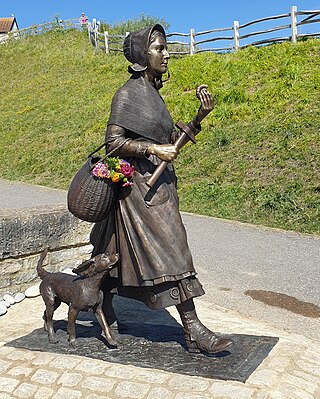
The Statue of Mary Anning is a bronze sculpture of the paleontologist Mary Anning in Lyme Regis.



